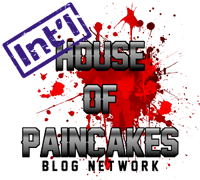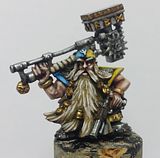Eighth Edition Notes
You can always measure before doing anything.
There are no partials under templates.
Line of Sight – Ignore weapons, banners, armaments, wings, and tails.
Movement
Models have to be one inch apart from friend and foe at all times. Units can reform, but can't do anything else unless they have a musician. If you want to redirect a charge, you must take and pass a leadership test. Charges are 2d6+M. If you fail, you move the higher of the 2d6.
Flanks and rears are determined by where the majority of the models in the front rank of the chargers are.
Units under 25% can rally on double ones. Units that are fleeing move 2d6 in the direction that they are already facing.
Units moving backwards move at ½ rate. Same thing with moving sideways. You can't move backwards/forwards/sideways in the same movement. Round halves up (e.g. half of five equals three).
Marching is the same, but you can not be march blocked if you pass a leadership test.
Single models move like units except they can pivot on the spot as many times as they want to do so. This includes monsters and chariots.
Magic
The number of spells a wizard knows is equivalent to his wizard level. You have to choose your lore when you make your list, not at game time. You roll for spells at game time before deployment. The player whose turn it is rolls 2d6 and has that many power dice. The other player gets the higher of the two dice as dispel dice. The casting player then rolls a d6 for each of his wizards, and on a six gets another power die. Dispelling player does the same for dispel dice with his wizards. You can never have more than 12 power/dispel dice at any point in the magic phase.
Restrictions on general spellcasting: target must be in wizard's forward arc, wizard does not need line of sight, target must be in range, no targeting close combat.
Magic missiles require line of sight. Augment/hex spells can be cast into combat and don't need to be in the front arc.
Any wizard can cast with between one and six power dice. Add the total on the dice to the wizard's level. That is what you rolled.
Spells that are boosted have to be declared beforehand. For example, casting the higher strength fireball.
Any dice roll total below a three is a failed cast.
If you fail to cast, you cannot cast with that wizard again for the rest of the magic phase.
Double sixes when casting are irresistible and miscast. Double sixes when dispelling automatically get rid of the spell, but don't cause any miscast.
Remains in play spells can be dispelled later with dispel dice or power dice.
Bound spells – Require dice to cast, with the level of the bound spell being the casting target. If you fail, you can still cast more spells. You cannot add your wizard level to the roll to cast the bound spell. Double sixes cause the item to crumble, but no miscast table. Models with innate bound spells (warrior priests) cannot cast more if they double six.
You can switch between wizards as much as you want. Each wizard can only cast each spell once.
Shooting
Models can fire in two ranks.
Soft cover is from hedges/fences. Hard cover is from walls, boulders, building and other units. Soft cover gives -1 to hit, hard cover gives a -2.
Close Combat
The second row can make supporting attacks to the front, but not the side or rear. Only a single attack can be made. If you're in a “horde”, then you can attack in three ranks. Fight in initiative order always. Ties in initiative make simultaneous attacks. Casualties are removed from the back rank. Removing casualties does not change the number of models that can attack back, as long as you have models to replace them.
Combat resolution: +1 for each wound done, +1 for charging, +1 for each rank up to three (counted at the end of combat), +1 for a standard, +1 for a flank (no minimum unit size), +2 for a rear (no minimum unit size), +1 if you charged from high ground, +1 for BSB, +1 for overkill in challenges, up to +5). To break ranks, flanking or rear units need to have two ranks.
Steadfast – Units with more ranks at the end of combat are stubborn on their own or the general's leadership. This happens even if ranks are broken.
Reforming – If you win and the opponent doesn't flee, you can reform. If you lose, you can take a leadership test and if passed can reform. Units that restrain and do not pursue can reform.
Fleeing or pursuing units that hit impossible terrain now stop one inch away.
If a unit leaves combat due to shrinking ranks, it is moved back in.
Special Rules
Always Strikes First – Cancels out Always Strikes Last, and if you have higher initiative you reroll to hit.
Breath Weapons – Used once per game as a shooting attack or 2d6 automatic hits in close combat.
Fast Cavalry – Can march and shoot, can move up to 12” after deployment.
Fear – Every round, non-fear unit in combat with fear unit must take a leadership check, if they fail must reduce WS to 1.
Flaming attacks cause fear in war beasts, cavalry, and chariots.
Frenzied units can take a leadership test to keep from charging. Frenzied troops do not parry.
Flying Cavalry are treated as fast cavalry with the flying rule.
Large target Generals and BSBs extend their radius to 18”.
Magic Resistance gives a ward save against spells.
Flaming attacks turn off regeneration for the remainder of the phase.
Paired weapons grant +1 attack.
Stomp/Thunderstomp – Creatures with this rule do 1/1d6 extra ASL attacks.
Strider – Units with this do not take dangerous terrain checks in dangerous terrain.
Stupidity – Units who fail move d6 forward.
Swiftstride – Units with this roll 3d6 to charge/flee/pursue and discard the lowest roll.
Skirmishers – Skirmishers are in normal formation but are 1/2” apart. They tighten up for combat. They can reform for free, fire on the march, and are at -1 to hit with shooting.
Terror can still make units flee when charged.
Unit Types
Monstrous infantry can make up to three attacks in support and get ranks for three models.
Calvary mounts do not make supporting attacks.
Swarms are no skirmishers.
Weapons
Parry now gives a 6+ ward save in close combat.
Great weapons on mounted units now give +2 strength.
Etcetera
Look out sir can be used on infantry models on their own if they are within 3” of a unit with at least five models. However, it only works on a 4+.
Characters can be moved into base to base with the enemy at the start of a combat.
Ridden monsters give a +1 armor save to their riders. Templates hit both rider and mount. Templates with different strengths (stone throwers) must randomize as to which gets hit at the higher strength.
BSB effect allows the reroll of all leadership checks.
War machines use the machine's toughness against shooting attacks.
You can march, etc. through terrain, but anytime you do anything but move regularly, you have to take a dangerous terrain check (roll a d6, on a 1 take a wound with no armor allowed). Calvary, monstrous calvary, and chariots treat anything that is not normal terrain as dangerous. Chariots take d6 wounds.
No marching in rivers.
Flyers can land and take off in forests, but must make dangerous terrain checks.
Marshes require calvary, monstrous calvary, and chariots to fail dangerous terrain checks on a 1 or 2.
An army must contain at least three units that are not characters. You can only duplicate special choices up to three, and rares up to two.












Thank you. This summary is genuinely quite useful for those of us still getting warmed up to the idea of WFB. Cheers.
ReplyDeleteArrrrgggh! I'm very sad that my copy hasn't come in the mail yet. Thank you for the consensus. This is by far the bestest one I've read so far.
ReplyDeleteAye, a very nice summary of the rules as they stand now.
ReplyDeleteIf I may, I have one small correction and one additional comment to your list:
"You can never have more than (...) power/dispel dice at any point in the magic phase."
(...) should be replaced by 12*
Regarding hard cover, minimum 50 % of the model has to be hidden by the hard cover, for the bonus to apply. You measure from eye-level of the unit targetting the hiding model.
*I'm a bit unsure as to how this works in battles with allies, if it is 12 dice for each army, or if you count the whole alliance as a whole. I havn't found anything in the rulebook about scaling for larger battles neither, have you?
Thanks for making the list, greatly appreciated.
Thanks for the quick fix, and I'm glad you all enjoyed it!
ReplyDeleteBen